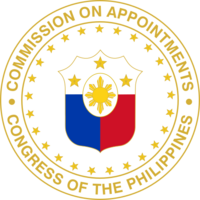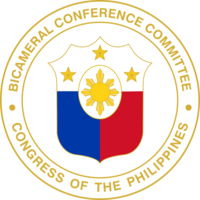Congress of the Philippines facts for kids
Quick facts for kids Congress of the PhilippinesKongreso ng Pilipinas (Filipino) |
|
|---|---|
| 20th Congress of the Philippines | |
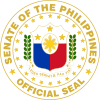 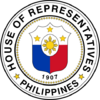
Seals of the Senate (left) and of the House of Representatives (right)
|
|
| Type | |
| Type | |
| Houses | Senate House of Representatives |
| History | |
| Founded | June 9, 1945 |
| Preceded by | National Assembly of the Philippines |
|
New session started
|
Begins on July 28, 2025 |
| Leadership | |
|
vacant
Since June 30, 2025 |
|
|
Speaker of the House of Representatives
|
vacant
Since June 30, 2025 |
| Structure | |
| Seats | 341 (see list) 24 senators 317 representatives |
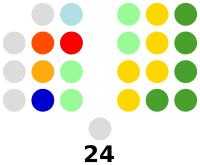 |
|
|
Senate political groups
|
|
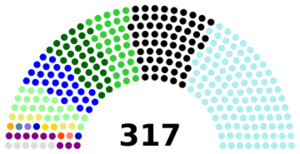 |
|
|
House of Representatives political groups
|
|
|
Joint committees
|
Joint committees are chaired by senators |
| Authority | Article VI of the Constitution of the Philippines |
| Elections | |
| Multiple non-transferable vote | |
| Parallel voting (Party-list proportional representation and first-past-the-post) | |
|
Senate last election
|
May 12, 2025 |
|
House of Representatives last election
|
May 12, 2025 |
|
Senate next election
|
May 8, 2028 |
|
House of Representatives next election
|
May 8, 2028 |
| Meeting place | |
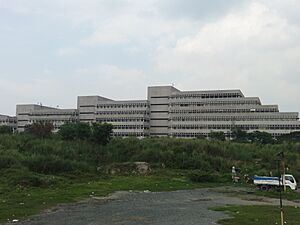 |
|
| The Senate meets at the GSIS Building, Financial Center, Jose W. Diokno Boulevard, Pasay | |
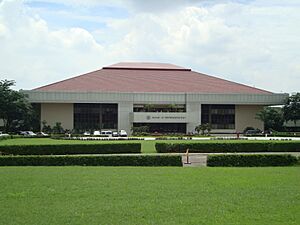 |
|
| The House of Representatives meets at the Batasang Pambansa Complex, Quezon City, which also hosts joint sessions | |
The Congress of the Philippines (called Kongreso ng Pilipinas in Filipino) is the main law-making body for the country. It has two parts, like a two-story building. The upper part is the Senate, and the lower part is the House of Representatives. Sometimes, when people say "Congress," they are just talking about the House of Representatives.
The Senate meets in the GSIS Building in Pasay City. The House of Representatives meets at the Batasang Pambansa Complex in Quezon City. Both houses can also meet together there for special events.
The Senate has 24 senators. Half of them are chosen every three years. This means each senator serves for six years in total. Senators are elected by the whole country, not just one area.
In the current 20th Congress, there are 317 members in the House of Representatives. The country's Constitution says there should be no more than 250 members, unless a law changes this. It also says that at least 20% of the members should represent specific groups.
There are two kinds of representatives in the House. Some represent a specific area, called a congressional district. All provinces have at least one district. Many cities also have their own districts. The number of districts has grown over time.
Other representatives are called party-list congressmen. They represent smaller groups of people, like workers' unions or rights groups. This helps these groups have a voice in Congress. As the number of districts grows, so does the number of party-list seats. This keeps the balance of representation fair.
Congress holds its regular meetings every year. These meetings start on the fourth Monday of July. A regular meeting can last until 30 days before the next one begins. The President can also call special meetings. These are usually for urgent issues or emergencies.
Contents
History of the Philippine Congress
Early Beginnings Under Spain
During the time Spain ruled the Philippines, local councils called Cabildos were set up. One famous example was the Cabildo in Manila, started in 1571.
For a long time, the Philippines had no say in the Spanish government. But in 1809, the Philippines became a full part of Spain. This allowed it to send representatives to the Spanish Cortes (parliament). The first delegates were Pedro Pérez de Tagle and José Manuel Couto. They had no real connection to the Philippines.
Later, Ventura de los Reyes was chosen as Manila's delegate. He arrived in Spain in December 1811. However, when the Spanish king returned to power in 1814, he ended this representation. Filipinos who wanted more rights, called the Ilustrados, fought to get it back.
Revolutionary Times
The fight for rights turned into the Philippine Revolution. This aimed to remove Spanish rule. After declaring independence in 1898, President Emilio Aguinaldo called for a special meeting. This was the Malolos Congress. It created the Malolos Constitution.
Spain then gave the Philippines to the United States in the Treaty of Paris. Filipino revolutionaries fought against the Americans in the Philippine–American War. But they were defeated when Aguinaldo was captured in 1901.
Under American Rule
When the United States ruled the Philippines, the first law-making body was the Philippine Commission (1900-1907). The US President chose its members. Filipinos also had two Resident Commissioners in the US House of Representatives. They could speak but not vote.
In 1902, the Philippine Bill of 1902 created a two-part legislature. The Philippine Commission was the upper house. The Philippine Assembly was the lower house. This new system started in 1907.
In 1916, the Jones Law changed things again. The Philippine Commission was removed. A new two-part Philippine Legislature was created. It had a House of Representatives and a Senate.
Commonwealth and Second Republic
The law-making system changed again in 1935. The 1935 Constitution created the Commonwealth of the Philippines. This gave Filipinos more control. It also set up a single-chamber National Assembly.
But in 1940, the Constitution was changed. It brought back a two-part Congress. This new Congress had a House of Representatives and a Senate. Members elected in 1941 could not serve right away because World War II started. The Japanese took over and set up their own National Assembly. After Japan was defeated in 1945, the Commonwealth Congress returned. This system continued until the Philippines became independent in 1946.
After Independence
When the Philippines became a republic on July 4, 1946, the existing Congress became the First Congress of the Republic. New Congresses were elected until President Ferdinand Marcos declared martial law in 1972. Marcos then ruled by himself.
In 1973, a new Constitution was approved. It removed the two-part Congress. It created a single-chamber National Assembly, later called the Batasang Pambansa. This body first met in 1978.
After the People Power Revolution, President Corazon Aquino took over. A new Constitution was approved in 1987. It brought back the two-part Congress of the Philippines. The restored Congress first met in 1987.
Where Congress Meets
The two parts of Congress meet in different places in Metro Manila. The Senate meets at the GSIS Building in Pasay City. The House of Representatives meets at the Batasang Pambansa Complex in Quezon City. These two places are about 25 kilometers (15 miles) apart.
The Barasoain Church in Malolos, Bulacan was once a meeting place for the first Philippine Congress.
After the Americans took over, the US-created Philippine Legislature met at the Ayuntamiento in Intramuros, Manila. This was from 1907 to 1926. Then, it moved to the Old Legislative Building. The Senate used the upper floors, and the House used the lower floors.
The Legislative Building was destroyed in 1945 during the Battle of Manila. The Congress then met at an old Japanese Schoolhouse in Sampaloc. The Senate later moved to the Manila City Hall. Both houses returned to the rebuilt Legislative Building in 1950.
In 1973, when President Marcos ruled by decree, Congress was closed. Marcos built a new place for a single parliament in Quezon City. This became the Batasang Pambansa Complex. The parliament, called the Batasang Pambansa, first met there in 1978.
After Marcos was removed, the two-part Congress came back. The House of Representatives kept the Batasang Pambansa Complex. The Senate returned to the old Congress Building. In 1997, the Senate moved to a new building in Pasay City. The old Congress Building is now the National Museum of Fine Arts. The Senate plans to move to a new building in Fort Bonifacio, Taguig in the future.
What Congress Does
The Congress of the Philippines has many important jobs. These can be grouped into different types of powers:
Making Laws
This is the main job of Congress. They create laws that guide how people interact with each other. They also make laws about how people interact with the government.
Hidden Powers
These are powers that Congress needs to do its main jobs effectively. They are not directly written but are necessary.
Basic Powers
These powers are not directly given but are needed for Congress to exist. Examples include:
- Setting its own rules for meetings.
- Making sure enough members are present to do business.
- Keeping records of its meetings.
Specific Law-Making Powers
The Constitution clearly states these powers. Some examples are:
- Deciding how government money is spent (power to appropriate).
- Changing the Constitution (acting as a constituent assembly).
- Removing officials from office (power to impeach). The House starts the process, and the Senate holds the trial.
- Approving agreements with other countries (only the Senate does this).
- Declaring war (both houses must agree in a joint meeting).
- Approving forgiveness for crimes (amnesty).
- Counting votes for President and Vice-President.
- Setting taxes.
Executive Powers
Some powers of Congress are like those of the President. These include:
- Choosing its own leaders.
- Approving agreements with other countries.
- Confirming people the President chooses for certain jobs through the Commission on Appointments.
- The power to remove officials.
Supervising Powers
Congress watches over the government's other branches. For example, they can:
- Decide if a new government department should be created.
- Define the jobs and duties of government officials.
- Set aside money for government work.
- Set rules for how things should be done.
Election-Related Powers
Congress also has powers related to elections:
- Electing their own leaders.
- Counting votes for President and Vice-President.
- Choosing the President if there is a tie in the election.
Judicial Powers
Each house of Congress has some powers like a court:
- They can punish their own members for bad behavior. They can even suspend or remove a member if two-thirds of them agree.
- They approve amnesty declared by the President of the Philippines.
- They start and decide cases of impeachment.
- They decide election disputes for their own members through special tribunals.
Other Powers
The Constitution gives Congress other powers, such as:
- Allowing the Commission on Audit to check government money.
- Allowing the President to set tariffs (taxes on imports).
- Allowing the President to make rules during emergencies.
- Redrawing legislative districts based on population.
- Making laws about self-governing regions.
- Setting up a national language commission.
- Making public secondary education free.
- Allowing small-scale use of natural resources.
- Defining forest lands and national parks.
- Deciding who owns ancestral lands.
- Setting up independent economic and planning groups.
How a Bill Becomes a Law
Making a new law is a long process. Here are the steps:
- Writing the Bill
- A member of Congress, or a special team, writes the idea for a new law.
- First Reading
- The bill is given a number and copied.
- A few days later, its title and number are read out loud.
- The Speaker sends the bill to the right committee.
- Committee Review
- The committee checks the bill to see if public meetings are needed.
- If so, they set a time, announce it, and invite experts and people from the public.
- If not, they just discuss the bill among themselves.
- Based on discussions, the committee might change the bill. They might combine it with other bills or write a new one.
- The committee then approves a report about the bill. This report is sent to the main meeting area.
- The committee checks the bill to see if public meetings are needed.
- Second Reading
- The committee report is recorded and sent to the Rules Committee.
- The Rules Committee decides when the bill will be discussed by all members.
- During the Second Reading, the bill's number, title, and full text are read. Then:
- Members discuss and debate the bill.
- Members can suggest changes (amendments).
- Members vote. This can be by:
- Shouting "yes" or "no" (viva voce).
- Counting members who stand up.
- Dividing the House into "yes" and "no" groups.
- Calling out each member's name for a recorded vote.
- Third Reading
- Any changes made are added to the bill, and new copies are printed.
- These copies are given to all members three days before the Third Reading.
- During the Third Reading, only the bill's number and title are read.
- Members vote by roll call. A member can explain their vote for three minutes. No more changes can be made at this point.
- If most members present vote "yes," the bill is approved.
- If it's not approved, it is stored away.
- Sending to the Senate
- If the House approves the bill, it is sent to the Senate for their approval.
- Senate Action
- The bill goes through the same steps in the Senate.
- Conference Committee
- If the House and Senate approve different versions of the bill, a special committee is formed. It has members from both houses.
- This committee works to fix any differences in the bill. They can even add new parts related to the bill's topic.
- The committee writes a report, which all members sign.
- Both houses then vote on this report. No changes are allowed at this stage.
- Sending to the President
- Once both houses approve the bill, copies are signed by the Senate President and the Speaker of the House.
- These copies are then sent to the President.
- President's Decision
- If the President approves the bill, it becomes a law and gets a Republic Act (RA) number. It is sent back to the house where it started.
- After Approval
- The new law is copied and published so everyone knows about it. It is also added to the yearly list of laws.
- If the President Says No (Veto)
- If the President does not approve the bill, they send it back with their reasons.
- Congress can try to pass the bill again. If two-thirds of the members in each house vote "yes," the bill becomes a law even without the President's approval.
Congress Members and Leadership
The diagrams below show how Congress is made up. The colors show the political party of the leaders. Groups are formed based on how members vote for the Speaker or Senate President.
The Senate members are those who won the 2022 and 2025 Senate elections. The House of Representatives members are those who won the 2025 House of Representatives elections. In both houses, the majority group supports the current President. The minority groups are those who do not. The House of Representatives also has an independent minority group and some empty seats.
The number of members a group has affects how many spots they get on committees. Only members of the majority and minority groups get committee spots. In the Philippines, political parties can be flexible. It is common for members of the same party to be in different groups.
Who Leads Congress?
Each house has a main leader. In the Senate, it is the Senate President. In the House of Representatives, it is the Speaker. Both are chosen by their fellow members. The Senate also has a Senate President pro tempore (a temporary president). The House has deputy speakers. Each house also has leaders who manage discussions.
How Votes are Counted
Here are the different vote requirements in the Congress of the Philippines:
| Requirement | Senate | House of Representatives | Joint session | All members |
|---|---|---|---|---|
| One-fifth |
|
N/A | N/A | |
| One-third | N/A |
|
N/A | N/A |
| Majority (50% +1 member) |
|
|
|
|
|
||||
| Two-thirds |
|
|
|
|
|
N/A | |||
| Three-fourths | N/A | N/A | N/A |
|
For most things, like approving bills, only a majority of the members who are present and voting is needed. But for some things, like choosing leaders, a majority of all members (even if some seats are empty) is needed.
Congress Sessions
A new session of Congress begins after every House of Representatives election. Under the 1935 Constitution, Senate elections in the middle of a term could change its members during a session. From 1945 to 1972, there were two Commonwealth Congresses and seven Republic Congresses. The 2nd Commonwealth Congress became the 1st Congress of the Republic.
Under the 1973 Constitution, the Batasang Pambansa was the law-making body, and it had two elections. Under the 1987 Constitution, Senate elections happen at the same time as House elections. The first Congress under this Constitution was called the "8th Congress", continuing the count from the last Congress under the 1935 Constitution.
Congress Over Time
| When it Operated | What Law Guided It | Government Type | Name of Legislature | How Many Parts | Upper House | Lower House |
|---|---|---|---|---|---|---|
| 1898–99 | Malolos Constitution | Malolos Congress | Unicameral (one part) | Malolos Congress | ||
| War powers of the President of the United States | Martial law; military governor made rules | |||||
| 1900–1902 | Malolos Constitution | Malolos Congress | Unicameral | Malolos Congress | ||
| Chosen by the President of the United States | Taft Commission | Unicameral | Philippine Commission | |||
| 1902–1907 | Philippine Organic Act | Philippine Commission | Unicameral | |||
| 1907–1916 | Philippine Legislature | Bicameral (two parts) | Philippine Commission | Philippine Assembly | ||
| 1916–1935 | Philippine Autonomy Act | Bicameral | Senate | House of Representatives | ||
| 1935–1941 | 1935 Constitution | National Assembly | Unicameral | National Assembly | ||
| 1942–43 | War powers of the Emperor of Japan | Martial law; governor-general made rules | ||||
| 1943–44 | 1943 Constitution | National Assembly | Unicameral | National Assembly | ||
| 1945–46 | Changes to the 1935 Constitution | Congress (Commonwealth) | Bicameral | Senate | House of Representatives | |
| 1946–1973 | Congress | Bicameral | ||||
| 1973–1976 | 1973 Constitution | Martial law; president made rules | ||||
| 1976–1978 (never met) |
Batasang Bayan | Unicameral | National Assembly | |||
| 1978–1986 | Changes to the 1973 Constitution | Batasang Pambansa | Unicameral | Batasang Pambansa | ||
| 1986–1987 | President made rules | |||||
| 1987–present | 1987 Constitution | Congress | Bicameral | Senate | House of Representatives | |
Latest Elections
Senate Elections
In the Philippines, Senate election results are often shown by listing candidates from most to least votes. The twelve candidates with the highest number of votes are elected.
| Candidate | Party | Votes | % | ||
|---|---|---|---|---|---|
| DuterTen | Partido Demokratiko Pilipino | 27,121,073 | 6.33 | ||
| KiBam | Katipunan ng Nagkakaisang Pilipino | 20,971,899 | 4.89 | ||
| DuterTen | Partido Demokratiko Pilipino | 20,773,946 | 4.85 | ||
| Alyansa para sa Bagong Pilipinas | Lakas–CMD | 17,118,881 | 4.00 | ||
| KiBam | Liberal Party | 15,343,229 | 3.58 | ||
| DuterTen | Independent | 15,250,723 | 3.56 | ||
| Alyansa para sa Bagong Pilipinas | Independent | 15,106,111 | 3.53 | ||
| Alyansa para sa Bagong Pilipinas | Nationalist People's Coalition | 14,832,996 | 3.46 | ||
| Alyansa para sa Bagong Pilipinas | Nacionalista Party | 14,573,430 | 3.40 | ||
| Alyansa para sa Bagong Pilipinas | Nacionalista Party | 13,651,274 | 3.19 | ||
| Alyansa para sa Bagong Pilipinas | Nationalist People's Coalition | 13,394,102 | 3.13 | ||
| Nacionalista Party | 13,339,227 | 3.11 | |||
| Independent | 12,090,090 | 2.82 | |||
| Alyansa para sa Bagong Pilipinas | Lakas–CMD | 12,027,845 | 2.81 | ||
| Alyansa para sa Bagong Pilipinas | Nationalist People's Coalition | 11,808,645 | 2.76 | ||
| Alyansa para sa Bagong Pilipinas | Partido Federal ng Pilipinas | 11,580,520 | 2.70 | ||
| DuterTen | Partido Demokratiko Pilipino | 10,615,598 | 2.48 | ||
| Alyansa para sa Bagong Pilipinas | Partido Federal ng Pilipinas | 10,397,133 | 2.43 | ||
| DuterTen | Partido Demokratiko Pilipino | 10,241,491 | 2.39 | ||
| Riding-in-Tandem Team | Independent | 9,805,903 | 2.29 | ||
| Independent | 8,759,732 | 2.04 | |||
| Independent | 8,568,924 | 2.00 | |||
| DuterTen | Independent | 8,450,668 | 1.97 | ||
| DuterTen | Partido Demokratiko Pilipino | 8,383,593 | 1.96 | ||
| Alyansa para sa Bagong Pilipinas | Partido Federal ng Pilipinas | 7,702,550 | 1.80 | ||
| DuterTen | Partido Demokratiko Pilipino | 7,471,704 | 1.74 | ||
| Aksyon Demokratiko | 7,371,944 | 1.72 | |||
| Reform PH Party | 6,700,772 | 1.56 | |||
| Partido Lakas ng Masa | 6,481,413 | 1.51 | |||
| DuterTen | Independent | 5,789,181 | 1.35 | ||
| DuterTen | Independent | 5,719,041 | 1.33 | ||
| Makabayan | 4,648,271 | 1.08 | |||
| Makabayan | 4,343,773 | 1.01 | |||
| Partido Lakas ng Masa | 4,136,899 | 0.97 | |||
| Makabayan | 4,091,257 | 0.95 | |||
| Riding-in-Tandem Team | Nacionalista Party | 3,950,051 | 0.92 | ||
| Makabayan | 3,927,784 | 0.92 | |||
| Workers' and Peasants' Party | 3,865,792 | 0.90 | |||
| Makabayan | 3,846,216 | 0.90 | |||
| Makabayan | 3,670,972 | 0.86 | |||
| Independent | 2,556,983 | 0.60 | |||
| Independent | 2,389,847 | 0.56 | |||
| Independent | 1,150,095 | 0.27 | |||
| Independent | 1,032,201 | 0.24 | |||
| Partido Demokratiko Sosyalista ng Pilipinas | 990,091 | 0.23 | |||
| Makabayan | 829,084 | 0.19 | |||
| Partido Pilipino sa Pagbabago | 818,437 | 0.19 | |||
| Katipunan ng Kamalayang Kayumanggi | 801,677 | 0.19 | |||
| Makabayan | 779,868 | 0.18 | |||
| Makabayan | 744,506 | 0.17 | |||
| Partido Maharlika | 731,453 | 0.17 | |||
| Independent | 671,818 | 0.16 | |||
| Independent | 618,943 | 0.14 | |||
| Independent | 611,432 | 0.14 | |||
| Bunyog Party | 607,642 | 0.14 | |||
| Aksyon Demokratiko | 587,098 | 0.14 | |||
| Aksyon Demokratiko | Independent | 571,637 | 0.13 | ||
| Makabayan | 564,948 | 0.13 | |||
| Makabayan | 554,385 | 0.13 | |||
| Independent | 476,855 | 0.11 | |||
| Partido Maharlika | 460,662 | 0.11 | |||
| Kilusang Bagong Lipunan | 458,383 | 0.11 | |||
| Independent | 448,794 | 0.10 | |||
| Workers' and Peasants' Party | 414,027 | 0.10 | |||
| Democratic Party of the Philippines | 383,534 | 0.09 | |||
| Independent | 310,562 | 0.07 | |||
| Total | 428,489,615 | 100.00 | |||
| Total votes | 57,350,958 | – | |||
| Registered voters/turnout | 69,673,655 | 82.31 | |||
| Source: COMELEC | |||||
House of Representatives Elections
Voters for the House of Representatives get two votes. One vote is for a representative in their local area (congressional district). The other vote is for a party in the party-list system. Party-list representatives should make up no more than 20% of the House.
To win party-list seats, a party usually needs to get at least 2% of the national vote. The party with the most votes can win up to three seats. Other winning parties usually get two seats. If not enough seats are filled this way, parties with less than 2% of the vote can get one seat each until the 20% requirement is met.
District Elections
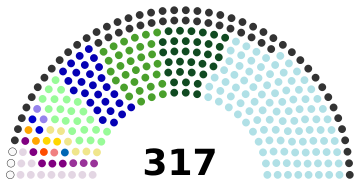 |
||||||
| Party | Votes | % | +/– | Seats | +/– | |
|---|---|---|---|---|---|---|
| Lakas–CMD | 16,596,698 | 32.87 | +23.70 | 103 | +77 | |
| National Unity Party | 6,080,987 | 12.05 | +0.13 | 32 | −1 | |
| Nationalist People's Coalition | 5,974,201 | 11.83 | −0.60 | 31 | −4 | |
| Partido Federal ng Pilipinas | 5,286,538 | 10.47 | +9.53 | 27 | +25 | |
| Nacionalista Party | 4,724,803 | 9.36 | −4.38 | 22 | −14 | |
| Liberal Party | 1,555,941 | 3.08 | −0.70 | 6 | −4 | |
| Aksyon Demokratiko | 1,341,540 | 2.66 | +0.72 | 2 | +2 | |
| Partido Demokratiko Pilipino | 666,067 | 1.32 | −21.45 | 2 | −64 | |
| Hugpong sa Tawong Lungsod | 542,710 | 1.07 | +0.93 | 3 | +3 | |
| Laban ng Demokratikong Pilipino | 314,981 | 0.62 | −0.16 | 2 | +1 | |
| People's Reform Party | 292,665 | 0.58 | −1.38 | 1 | −2 | |
| Pwersa ng Masang Pilipino | 269,949 | 0.53 | +0.52 | 2 | +2 | |
| United Bangsamoro Justice Party | 236,857 | 0.47 | −0.14 | 0 | 0 | |
| Unang Sigaw | 183,912 | 0.36 | −0.29 | 0 | 0 | |
| Makatizens United Party | 150,189 | 0.30 | New | 2 | New | |
| Sama Sama Tarlac | 143,868 | 0.28 | New | 0 | 0 | |
| United Nationalist Alliance | 142,655 | 0.28 | +0.14 | 1 | 0 | |
| Katipunan ng Nagkakaisang Pilipino | 134,137 | 0.27 | +0.26 | 0 | 0 | |
| National Unity Party/United Negros Alliance | 130,023 | 0.26 | −0.27 | 1 | −1 | |
| Centrist Democratic Party of the Philippines | 127,646 | 0.25 | −0.02 | 1 | 0 | |
| Partido Navoteño | 116,622 | 0.23 | +0.06 | 1 | 0 | |
| One Capiz | 109,249 | 0.22 | New | 0 | 0 | |
| Reform PH Party | 107,966 | 0.21 | New | 0 | 0 | |
| Lakas–CMD/One Cebu | 104,768 | 0.21 | New | 1 | New | |
| Adelante Zamboanga Party | 100,035 | 0.20 | +0.05 | 1 | 0 | |
| Padajon Surigao Party | 99,856 | 0.20 | New | 0 | 0 | |
| Galing at Serbisyo para sa Mindoreño | 91,073 | 0.18 | New | 0 | 0 | |
| Filipino Rights Protection Advocates of Manila Movement | 87,183 | 0.17 | New | 0 | 0 | |
| Nationalist People's Coalition/One Cebu | 74,936 | 0.15 | New | 1 | New | |
| Asenso Manileño | 70,780 | 0.14 | New | 1 | 0 | |
| Akay National Political Party | 68,524 | 0.14 | New | 0 | 0 | |
| Workers' and Peasants' Party | 50,618 | 0.10 | +0.00 | 0 | 0 | |
| Kusog Bicolandia | 33,789 | 0.07 | New | 0 | 0 | |
| Partido Lakas ng Masa | 28,746 | 0.06 | +0.05 | 0 | 0 | |
| Asenso Abrenio | 23,308 | 0.05 | New | 0 | 0 | |
| Makabayan | 22,698 | 0.04 | New | 0 | 0 | |
| Partido Demokratiko Sosyalista ng Pilipinas | 14,343 | 0.03 | −0.13 | 0 | 0 | |
| Partido para sa Demokratikong Reporma | 12,672 | 0.03 | −0.96 | 0 | 0 | |
| Independent | 4,371,611 | 8.66 | +4.23 | 11 | +5 | |
| Party-list seats | 63 | 0 | ||||
| Total | 50,485,144 | 100.00 | – | 317 | +1 | |
| Valid votes | 50,485,144 | 88.46 | +1.48 | |||
| Invalid/blank votes | 6,585,150 | 11.54 | −1.48 | |||
| Total votes | 57,070,294 | 100.00 | – | |||
| Registered voters/turnout | 68,431,965 | 83.40 | −0.70 | |||
| Source: COMELEC (results per district, registered voters) | ||||||
Party-list Election
| Party | Votes | % | +/– | Seats | +/– | |
|---|---|---|---|---|---|---|
| Akbayan | 2,779,621 | 6.63 | +5.99 | 3 | +2 | |
| Duterte Youth | 2,338,564 | 5.57 | +3.93 | 3 | +2 | |
| Tingog Party List | 1,822,708 | 4.34 | +1.93 | 3 | +1 | |
| 4Ps Partylist | 1,469,571 | 3.50 | +1.20 | 2 | 0 | |
| ACT-CIS Partylist | 1,239,930 | 2.96 | −2.78 | 2 | −1 | |
| Ako Bicol | 1,073,119 | 2.56 | +0.34 | 2 | 0 | |
| Uswag Ilonggo | 777,754 | 1.85 | −0.02 | 1 | 0 | |
| Solid North Party | 765,322 | 1.82 | New | 1 | New | |
| Trabaho Partylist | 709,283 | 1.69 | +1.31 | 1 | +1 | |
| Citizens' Battle Against Corruption | 593,911 | 1.42 | −0.31 | 1 | 0 | |
| Malasakit at Bayanihan | 580,100 | 1.38 | +0.44 | 1 | 0 | |
| Senior Citizens Partylist | 577,753 | 1.38 | −0.29 | 1 | 0 | |
| Puwersa ng Pilipinong Pandagat | 575,762 | 1.37 | New | 1 | New | |
| Mamamayang Liberal | 547,949 | 1.31 | New | 1 | New | |
| FPJ Panday Bayanihan | 538,003 | 1.28 | New | 1 | New | |
| United Senior Citizens Partylist | 533,913 | 1.27 | +0.40 | 1 | 0 | |
| 4K Partylist | 521,592 | 1.24 | New | 1 | New | |
| LPG Marketers Association | 517,833 | 1.23 | +0.00 | 1 | 0 | |
| Coop-NATCCO | 509,913 | 1.22 | +0.28 | 1 | 0 | |
| Ako Bisaya | 477,796 | 1.14 | −0.25 | 1 | 0 | |
| Construction Workers Solidarity | 477,517 | 1.14 | +0.02 | 1 | 0 | |
| Pinoy Workers Partylist | 475,985 | 1.13 | New | 1 | New | |
| AGAP Partylist | 469,412 | 1.12 | +0.12 | 1 | 0 | |
| Asenso Pinoy | 423,133 | 1.01 | +0.38 | 1 | +1 | |
| Agimat Partylist | 420,813 | 1.00 | −0.59 | 1 | 0 | |
| TGP Partylist | 407,922 | 0.97 | +0.08 | 1 | 0 | |
| SAGIP Partylist | 405,297 | 0.97 | −1.15 | 1 | −1 | |
| Alona Partylist | 393,684 | 0.94 | +0.29 | 1 | 0 | |
| 1-Rider Partylist | 385,700 | 0.92 | −1.80 | 1 | −1 | |
| Kamanggagawa | 382,657 | 0.91 | New | 1 | New | |
| Galing sa Puso Party | 381,880 | 0.91 | +0.00 | 1 | 0 | |
| Kamalayan | 381,437 | 0.91 | +0.76 | 1 | +1 | |
| Bicol Saro | 366,177 | 0.87 | −0.01 | 1 | 0 | |
| Kusug Tausug | 365,916 | 0.87 | −0.18 | 1 | 0 | |
| Alliance of Concerned Teachers | 353,631 | 0.84 | −0.06 | 1 | 0 | |
| One Coop | 334,098 | 0.80 | +0.62 | 1 | +1 | |
| KM Ngayon Na | 324,405 | 0.77 | +0.59 | 1 | +1 | |
| Abante Mindanao | 320,349 | 0.76 | New | 1 | New | |
| Bagong Henerasyon | 319,803 | 0.76 | −0.14 | 1 | 0 | |
| Trade Union Congress Party | 314,814 | 0.75 | +0.04 | 1 | 0 | |
| Kabataan | 312,344 | 0.74 | +0.59 | 1 | 0 | |
| APEC Partylist | 310,427 | 0.74 | −0.00 | 1 | 0 | |
| Magbubukid | 310,289 | 0.74 | New | 1 | New | |
| 1Tahanan | 309,761 | 0.74 | +0.15 | 1 | +1 | |
| Ako Ilocano Ako | 301,406 | 0.72 | −0.33 | 1 | 0 | |
| Manila Teachers Party-List | 301,291 | 0.72 | +0.54 | 1 | 0 | |
| Nanay Partylist | 293,430 | 0.70 | New | 1 | New | |
| Kapuso PM | 293,149 | 0.70 | New | 1 | New | |
| SSS-GSIS Pensyonado | 290,359 | 0.69 | New | 1 | New | |
| DUMPER Partylist | 279,532 | 0.67 | −0.18 | 1 | 0 | |
| Abang Lingkod | 274,735 | 0.65 | −0.16 | 1 | 0 | |
| Pusong Pinoy | 266,623 | 0.64 | −0.07 | 1 | 0 | |
| Swerte | 261,379 | 0.62 | New | 1 | New | |
| Philreca Party-List | 261,045 | 0.62 | −0.04 | 1 | 0 | |
| Gabriela Women's Party | 256,811 | 0.61 | −0.54 | 0 | −1 | |
| Abono Partylist | 254,474 | 0.61 | −0.17 | 0 | −1 | |
| Ang Probinsyano Party-list | 250,886 | 0.60 | −1.34 | 0 | −1 | |
| Murang Kuryente Partylist | 247,754 | 0.59 | New | 0 | 0 | |
| OFW Partylist | 246,609 | 0.59 | −0.21 | 0 | −1 | |
| Apat-Dapat | 245,060 | 0.58 | +0.52 | 0 | 0 | |
| Tupad | 243,152 | 0.58 | New | 0 | 0 | |
| Kalinga Partylist | 235,186 | 0.56 | +0.41 | 0 | 0 | |
| 1-Pacman Party List | 233,096 | 0.56 | −0.18 | 0 | −1 | |
| Angat | 229,707 | 0.55 | −0.89 | 0 | −1 | |
| Magsasaka Partylist | 225,371 | 0.54 | −0.21 | 0 | −1 | |
| P3PWD | 214,605 | 0.51 | −0.55 | 0 | −1 | |
| Barangay Health Wellness Partylist | 203,719 | 0.49 | −0.42 | 0 | −1 | |
| Democratic Independent Workers Association | 195,829 | 0.47 | −0.17 | 0 | 0 | |
| Epanaw Sambayanan | 188,505 | 0.45 | New | 0 | 0 | |
| Probinsyano Ako | 185,606 | 0.44 | −0.84 | 0 | −1 | |
| Toda Aksyon | 183,111 | 0.44 | New | 0 | 0 | |
| Pinuno Partylist | 181,066 | 0.43 | −0.39 | 0 | −1 | |
| Serbisyo sa Bayan Party | 175,520 | 0.42 | New | 0 | 0 | |
| Abante Pangasinan - Ilokano Party | 170,795 | 0.41 | −0.82 | 0 | −1 | |
| AGRI Partylist | 168,032 | 0.40 | −0.67 | 0 | −1 | |
| Asap Na | 164,030 | 0.39 | New | 0 | 0 | |
| Bayan Muna | 162,894 | 0.39 | −0.21 | 0 | 0 | |
| Eduaksyon | 161,517 | 0.39 | New | 0 | 0 | |
| Akay ni Sol | 159,748 | 0.38 | New | 0 | 0 | |
| Ahon Mahirap | 157,991 | 0.38 | New | 0 | 0 | |
| 1Munti Partylist | 157,665 | 0.38 | New | 0 | 0 | |
| H.E.L.P. Pilipinas | 157,308 | 0.37 | +0.12 | 0 | 0 | |
| A Teacher Partylist | 157,116 | 0.37 | −0.23 | 0 | 0 | |
| Babae Ako | 157,041 | 0.37 | +0.26 | 0 | 0 | |
| Anakalusugan | 154,121 | 0.37 | −0.39 | 0 | −1 | |
| Pilipinas Babangon Muli | 154,025 | 0.37 | New | 0 | 0 | |
| Batang Quiapo Partylist | 153,637 | 0.37 | New | 0 | 0 | |
| Lunas | 151,494 | 0.36 | +0.08 | 0 | 0 | |
| Kabalikat ng Mamamayan | 141,847 | 0.34 | −0.42 | 0 | −1 | |
| WIFI | 141,041 | 0.34 | +0.03 | 0 | 0 | |
| Aangat Tayo | 140,597 | 0.34 | New | 0 | 0 | |
| Laang Kawal | 136,484 | 0.33 | New | 0 | 0 | |
| Ako Padayon | 134,292 | 0.32 | −0.04 | 0 | 0 | |
| Solo Parents | 131,659 | 0.31 | New | 0 | 0 | |
| Pamilya Ko | 124,228 | 0.30 | New | 0 | 0 | |
| Pamilyang Magsasaka | 117,440 | 0.28 | −0.15 | 0 | 0 | |
| ANGKASANGGA | 115,720 | 0.28 | New | 0 | 0 | |
| Kasambahay | 111,269 | 0.27 | New | 0 | 0 | |
| Bangon Bagong Minero | 111,174 | 0.27 | New | 0 | 0 | |
| Pamilya Muna | 108,483 | 0.26 | New | 0 | 0 | |
| Kababaihan | 107,848 | 0.26 | New | 0 | 0 | |
| AA-Kasosyo Party | 107,262 | 0.26 | New | 0 | 0 | |
| Tulungan Tayo | 106,504 | 0.25 | −0.15 | 0 | 0 | |
| Health Workers | 105,512 | 0.25 | New | 0 | 0 | |
| 1Agila | 104,868 | 0.25 | New | 0 | 0 | |
| Boses Party-List | 102,588 | 0.24 | −0.07 | 0 | 0 | |
| Buhay Party-List | 99,365 | 0.24 | −0.04 | 0 | 0 | |
| Ipatupad For Workers | 96,735 | 0.23 | +0.12 | 0 | 0 | |
| Gilas | 96,646 | 0.23 | New | 0 | 0 | |
| Bunyog Party | 93,825 | 0.22 | +0.07 | 0 | 0 | |
| Vendors Partylist | 88,845 | 0.21 | New | 0 | 0 | |
| Bayaning Tsuper | 84,204 | 0.20 | −0.23 | 0 | 0 | |
| Bisaya Gyud Party-List | 79,915 | 0.19 | −0.12 | 0 | 0 | |
| Magdalo Party-List | 78,984 | 0.19 | −0.13 | 0 | 0 | |
| Maharlikang Pilipino Party | 78,700 | 0.19 | +0.07 | 0 | 0 | |
| Arangkada Pilipino | 75,493 | 0.18 | New | 0 | 0 | |
| Bagong Maunlad na Pilipinas | 70,595 | 0.17 | New | 0 | 0 | |
| Damayang Filipino | 68,480 | 0.16 | New | 0 | 0 | |
| Partido sa Bagong Pilipino | 68,085 | 0.16 | New | 0 | 0 | |
| Heal PH | 67,085 | 0.16 | New | 0 | 0 | |
| Ang Tinig ng Seniors | 66,553 | 0.16 | −0.13 | 0 | 0 | |
| Ako OFW | 60,230 | 0.14 | −0.32 | 0 | 0 | |
| Aksyon Dapat | 58,916 | 0.14 | New | 0 | 0 | |
| Aktibong Kaagapay | 55,829 | 0.13 | +0.04 | 0 | 0 | |
| UGB Partylist | 53,633 | 0.13 | New | 0 | 0 | |
| Ang Komadrona | 53,017 | 0.13 | −0.04 | 0 | 0 | |
| United Frontliners | 52,338 | 0.12 | −0.02 | 0 | 0 | |
| Gabay | 52,109 | 0.12 | New | 0 | 0 | |
| Tictok | 51,354 | 0.12 | New | 0 | 0 | |
| Ako Tanod | 49,553 | 0.12 | New | 0 | 0 | |
| Barangay Natin | 49,364 | 0.12 | −0.11 | 0 | 0 | |
| Abante Bisdak | 49,114 | 0.12 | New | 0 | 0 | |
| Turismo | 47,645 | 0.11 | New | 0 | 0 | |
| Ang Bumbero ng Pilipinas | 47,027 | 0.11 | −0.07 | 0 | 0 | |
| BFF | 45,816 | 0.11 | New | 0 | 0 | |
| Pinoy Ako | 44,419 | 0.11 | New | 0 | 0 | |
| Patrol Partylist | 41,570 | 0.10 | −0.59 | 0 | −1 | |
| Tutok To Win Party-List | 41,036 | 0.10 | −1.76 | 0 | −1 | |
| Lingap | 38,564 | 0.09 | New | 0 | 0 | |
| Maagap | 35,871 | 0.09 | +0.04 | 0 | 0 | |
| PBA Partylist | 35,078 | 0.08 | −0.72 | 0 | −1 | |
| Ilocano Defenders | 32,028 | 0.08 | New | 0 | 0 | |
| Pamana | 31,526 | 0.08 | New | 0 | 0 | |
| Kaunlad Pinoy | 30,898 | 0.07 | New | 0 | 0 | |
| Juan Pinoy | 27,523 | 0.07 | New | 0 | 0 | |
| Rebolusyonaryong Alyansang Makabansa | 26,771 | 0.06 | −0.13 | 0 | 0 | |
| Arise | 26,565 | 0.06 | +0.01 | 0 | 0 | |
| Click Party | 25,914 | 0.06 | −0.09 | 0 | 0 | |
| MPBL Partylist | 23,189 | 0.06 | New | 0 | 0 | |
| PROMDI | 23,144 | 0.06 | New | 0 | 0 | |
| Bida Katagumpay | 20,885 | 0.05 | New | 0 | 0 | |
| Hugpong Federal | 19,028 | 0.05 | New | 0 | 0 | |
| Arte | 14,169 | 0.03 | −0.08 | 0 | 0 | |
| Peoples Champ Guardians Partylist | 11,492 | 0.03 | New | 0 | 0 | |
| Sulong Dignidad | 8,120 | 0.02 | New | 0 | 0 | |
| Total | 41,950,339 | 100.00 | – | 63 | 0 | |
| Valid votes | 41,950,339 | 73.15 | +7.47 | |||
| Invalid/blank votes | 15,400,619 | 26.85 | −7.47 | |||
| Total votes | 57,350,958 | – | – | |||
| Registered voters/turnout | 69,673,655 | 82.31 | −0.67 | |||
| Source: COMELEC (vote totals) | ||||||
Images for kids
See also
 In Spanish: Congreso de Filipinas para niños
In Spanish: Congreso de Filipinas para niños
- Politics of the Philippines
- Senate of the Philippines
- House of Representatives of the Philippines
- Legislative districts of the Philippines
- List of legislatures of the Philippines
- List of Philippine Senate committees
- List of Philippine House committees
- List of legislatures by country


